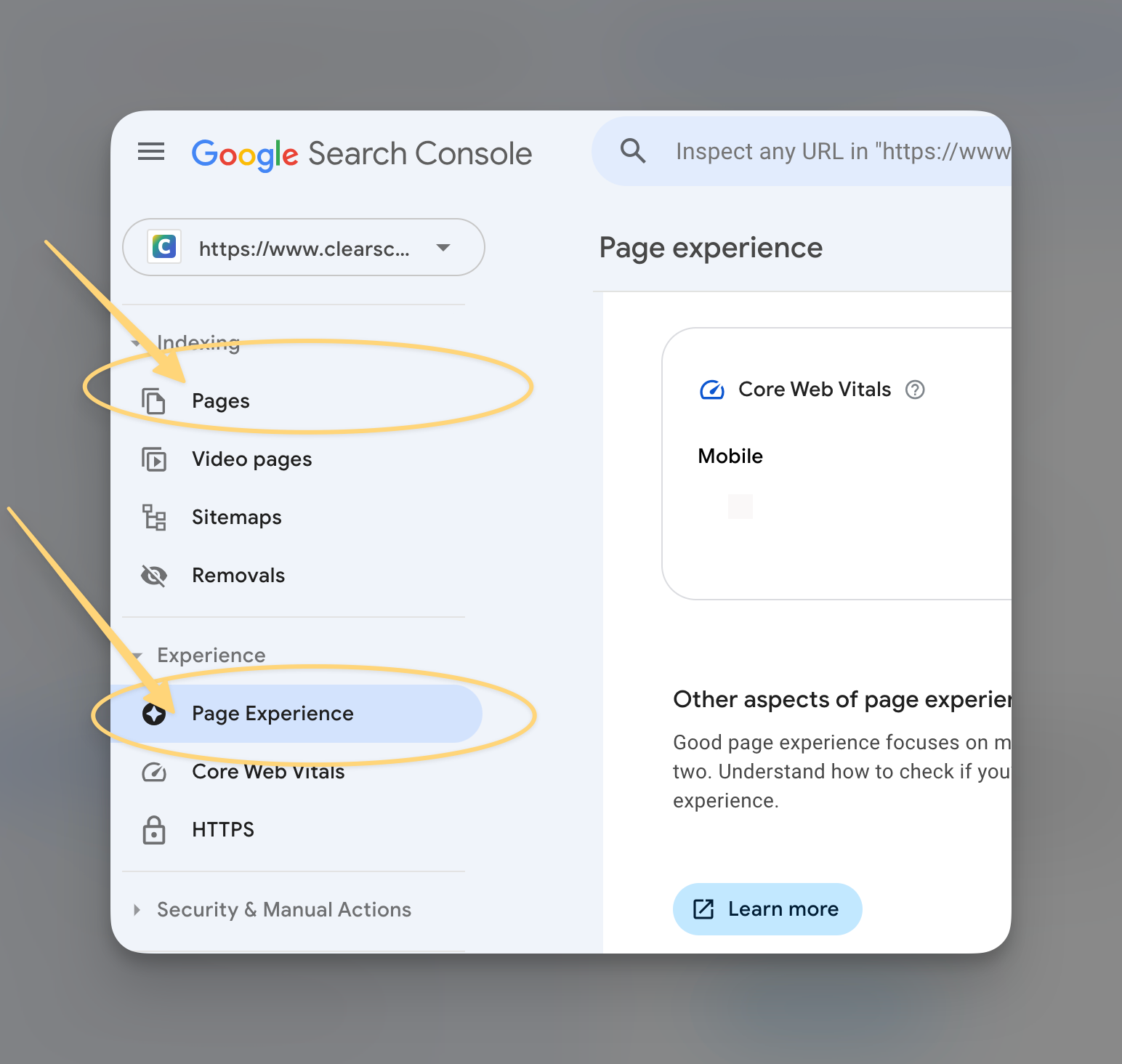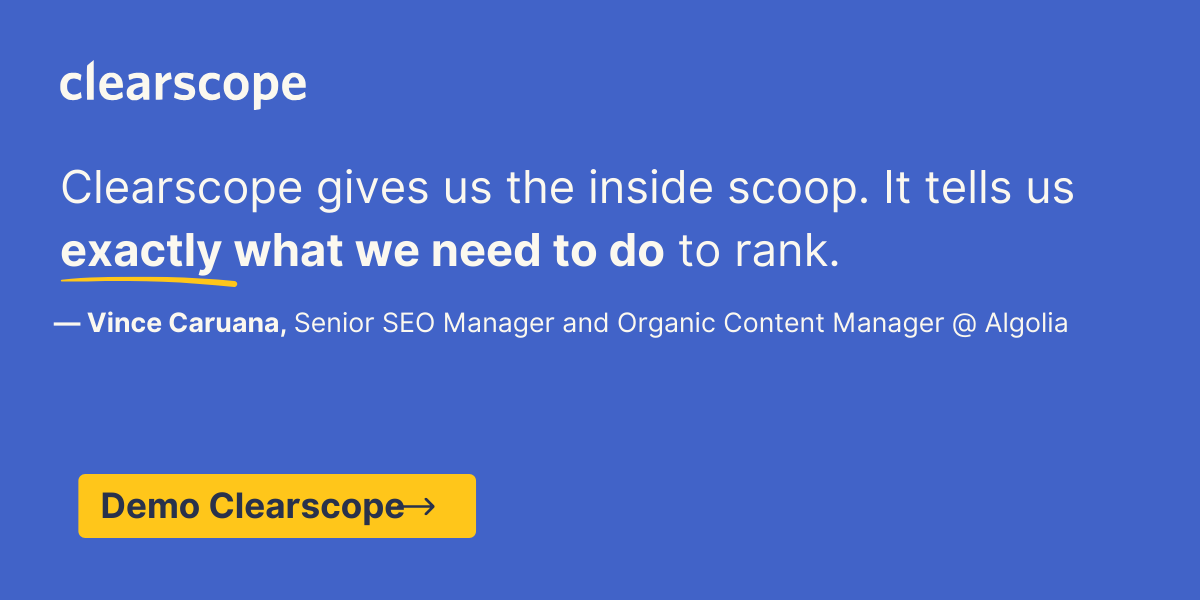Defend Your Search Visibility: Monitor Your Content’s Lifecycle End-To-End
Topic: Content Marketing
Published:
Written by: Bernard Huang
Can you protect your search visibility by monitoring the content lifecycle?
If you’re diving into comprehensive content lifecycle management (CLM), you really should have a solid understanding of how web content moves through performance stages.
It’s not enough to create a piece of content, publish it, and hope for the best… that’s the stuff of beginners.
You need to monitor your content's performance, keep it fresh, and stay ahead of content decay.
If you’re serious about protecting your hard-earned organic traffic and visibility throughout the content lifecycle, you need a solid content strategy and the right tools.
Hint: Clearscope is THE content-first SEO platform to optimize, monitor, and grow your SEO performance—and I’ll show you how to use it to simplify content lifecycle management in this guide.
(And while I may be a bit biased, I actually used Clearscope for years before joining the in-house team.)
However, if you’re not a Clearscope user, this article will still help. I’m not here to sell you any courses or templates—plus, there are zero affiliate links in this article. Promise.🤞

The stages of content lifecycle management
Listen.
If you’re going to manage a large library of web content effectively, you can’t wing it.
You must have a good understanding of the 4 stages of the content lifecycle (if you don’t already), so you can keep an eye on when—and how—to reoptimize your content to maintain healthy visibility.
For some of us, these “stages” have been intuitively understood during our SEO and content strategy careers without being named, but it’s good to put some labels on these concepts regardless.
The content lifecycle consists of four key phases:
New content
High growth
Peak performance
Content decay
Below, I’ll break down each stage—with examples—and give you my best tips for managing your content throughout the entire lifecycle.
Here, I'll quickly show you how I use Clearscope to monitor the different stages of the content lifecycle. (And a sneak peek of my cute cat, Marty, is included.)
1. New content
BAM! The content creation process ends, a piece of content is born, and it moves out of production and onto the web.
After you publish a piece of digital content, search engines begin to analyze and rank it. However, it can take time to see results.
During the first six to 18 months, your content is finding its place in the world, and it’s not yet a powerhouse of brand awareness sending signals for your services to your target audience.
This stage is where content creators focus on key elements like on-brand messaging, metadata, and search engine optimization (SEO).
It's crucial to have the right workflows in place to streamline your content planning and production—like a powerhouse SEO content brief—ensuring you're setting your business goals and content strategy up for success.
READ MORE: How to create the perfect SEO content brief in the era of AI-assisted content
What to monitor in this stage of the life cycle to encourage growth
Your new content needs to be internally linked into other pieces across your site. This can help search engines find and index your new page faster.
If you don’t use Clearscope, you can do this manually by ensuring any newly published posts are also linked into other, pre-existing pages on your site that are topically related.
If you are a Clearscope user, you can discover internal linking opportunities easily and quickly with the Internal Linking content view. (Below.)

If you use Clearscope, your Content Inventory will automatically provide you visibility into internal linking opportunities across your site. (To do so, just make sure you're monitoring the page in Clearscope.)
Clearscope automatically identifies any new pages in your Content Inventory that don't meet your internal linking requirements. For example, if you set a target of 5 internal links per page, Clearscope will highlight any pages with fewer than 5 links, making it easy to see where you need to add more.
Bonus? Clearscope will also show you the exact text in other pages to link your new page to.
You also should be on the lookout for any technical issues in your web content during this stage that are preventing its growth, like Google canonical errors or noindex issues.
You can do this via Google Search Console (GSC) under the Pages and/or the Page Experience tabs.

You can find technical issues that are affecting your site's SEO performance with Google Search Console via the "Indexing > Pages" tab and "Experience > Page Experience" tab.
Don’t consider yourself a “technical SEO?” You’re in luck.
Clearscope also makes this kind of monitoring super visible and straightforward via the Technical issues content view.
When you have a page in your inventory that experiences an error, you’ll be notified clearly without all the noise of other traditional monitoring tools.

With Clearscope, you'll be notified of any pages in your content inventory that are experiencing technical issues and how they relate to content performance.
2. High growth
Once your content starts to rank and gain traction, it enters the high-growth stage.
This is where your hard work to create effective content performs best, driving organic traffic, backlinks, and increased engagement.
External links bolster your content’s authority, pushing it higher in search engine results.
(And who doesn’t love those organically earned backlinks, am I right?)
Here’s what to monitor during the high growth stage to ensure you’re meeting marketing goals
During this phase, content strategists and team members should regularly keep an eye on these high-growth pages. That way, you can quickly see when there are further opportunities to optimize content.
This might include using analytics tools to track performance metrics, conversion rates, and user experience.
If you use Clearscope, you can set up Custom Content Views that will alert you to any volatile movement of your high-growth pages in the SERPs, or use the Striking Distance Queries View to find opportunities to earn more traffic on high-growth pages.

The Striking Distance Queries view notifies you of pages that could rank for additional search queries with just a few adjustments. In my own Clearscope Content Inventory, I've also created a couple custom views that alert me to when a page drops out of positions 1-3 and 1-10 to use during the high growth and peak content lifecycle stages.
You also can use heat map tools, like HotJar, to pinpoint where your visitors are engaging the most on the page to better optimize those hot spots with CTAs or links to supplemental pages.
And don’t skip driving continued growth through content orchestration.
Repurposing and reusing your high-performing content assets across various channels—like email marketing, social media, or even infographics—can keep your omnichannel content strategy strong.
READ MORE: What is content orchestration and why it matters for SEO
3. Peak
The peak phase is when your content reaches its maximum performance in the lifecycle.
(You’ve done great work, so pat yourself on the back.)
At this point, your piece of content may rank high in search engine results, but its growth will plateau. In fact, you should expect and plan for it.
If you’re working on a huge, enterprise-level site—depending on your enterprise content management system and digital asset management workflows—you’ll need careful failsafes in place to keep a close eye on this stage of the lifecycle.
You might notice competition pushing your content down in the SERPs or fluctuating positions and CTRs.
What metrics to monitor during the peak stage
Monitor for dips and crucial losses during this stage. You can do this with Google Search Console or traditional rank tracking tools.
With Clearscope, you can also monitor the Content Grade of your pages—which scores your content health—and set up Custom Content Views and alerts to notify you of changes in important KPIs.

Easily see your content's overall health so you can spot which pages need attention ASAP. Use Content Health indicators in your Clearscope Inventory Analytics as a guide. Yellow, orange, and red indicate pages that likely need a refresh.
If you have evidence that your page has plateaued, it’s time to review it.
Use optimization strategies like incorporating fresh data, improving the user experience, or even tweaking messaging to align with shifts in search intent.
4. Decay
Every piece of content, no matter how high quality, eventually reaches the decay stage.
As your content ages, it might lose relevance—especially if it contains outdated statistics, irrelevant case studies, or no longer addresses the pain points of your target audience.
This is where detailed content lifecycle management and monitoring becomes crucial.
To combat content decay, content teams need to update or repurpose content, implement automation for regular content audits, and look into initiatives like archiving content that is no longer useful.
6 causes of content decay (and how to tackle them)
Decreased relevance: Keep your content fresh and aligned with your brand voice by regularly updating statistics, trends, and customer experiences.
Lack of topical depth: Today’s algorithms reward in-depth, high-quality content. Avoid thin content by covering your topic comprehensively, demonstrating subject matter expertise and topical authority.
Internal competition: Prevent keyword cannibalization by managing similar pieces of content on your website.
External competition: Stay competitive by regularly refreshing your digital content and monitoring competitors’ new posts. Slight drops in rankings can lead to significant decreases in traffic for your most valuable content.
Search intent changes: Search engine algorithms prioritize user intent. If search intent around your target keywords shifts, you may need to update your content's messaging and format to stay relevant.
Algorithm changes: Keep an eye on Google’s updates, and adjust your strategy to reflect any major changes affecting content types and SEO best practices.
How to monitor for content decay
Not to sound like a broken record, but...
Clearscope makes monitoring for content decay incredibly easy, saving you hours—perhaps even days—previously wasted staring at spreadsheets.

Clearscope helps you monitor content performance in real-time, making it easy to identify content that’s losing value and needs attention.
How to fix content decay and stay competitive
You can’t really prevent the content decay stage of the content lifecycle; it’s likely to happen at some point for every site.
However, you can bake processes into your content production that address it quickly as soon as you spot the signs.
To keep your content lifecycle management process in top shape, content creators, strategists, and broader marketing teams need to collaborate across silos, using tools that streamline workflows and stakeholder approval processes.
Whether you're managing website content, authoring white papers, or publishing content across multiple channels, you’re going to need to stay organized.
And a content management solution that tracks your content through its entire lifecycle should be a part of that plan… and I'm not talking about a traditional CMS here.
Larger teams with high levels of content production need to monitor pages closely and continuously—that’s almost a full-time job in itself for some enterprise sites.
But tools like Clearscope provide the functionality to track content performance across your entire library, allowing you to optimize content continuously and maintain that sweet, sweet brand awareness and organic visibility.
Want to fix content decay and improve your organic traffic?
Start using Clearscope to monitor your content library and maximize your visibility.

How To Measure and Predict ROI for Your Content Marketing Strategy
Understanding how to calculate content marketing ROI is an essential step in tracking and communicating the effectiveness of your strategy.
Read moreHow to Add Information Gain to Your Content: 3-Phase Plan
In this straightforward, 3-part plan, you'll find out how incorporate information gain into your existing SEO content and test outcomes.
Read moreEnterprise SEO Tools to Support Content & Boost Site Rankings
Our post talks about six enterprise SEO tools to guide digital strategies, help you see better ROI from content marketing, and report on the success of projects.
Read more